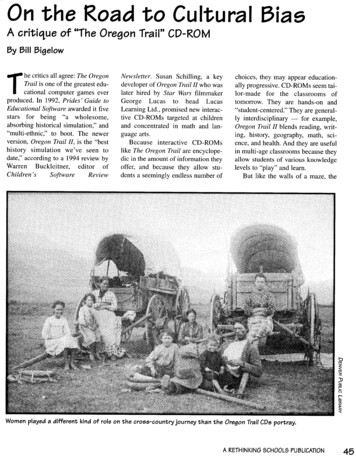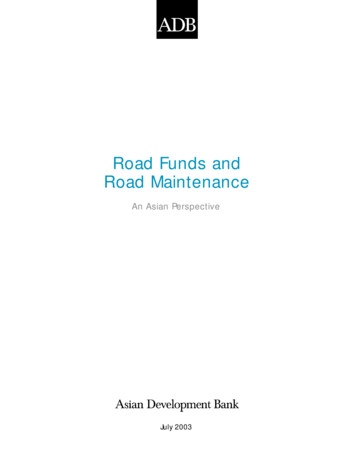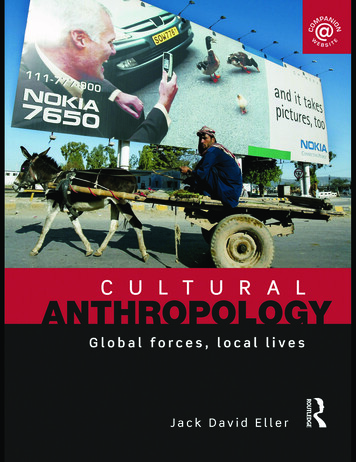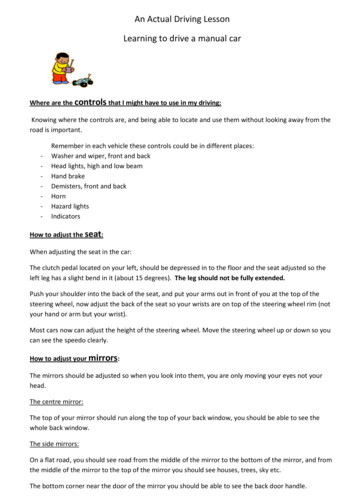
Transcription
On the Road to Cultural BiasA critique of "The Oregon Trail" CD-ROMBy Bill Bigelowhe critics all agree : The OregonTrail is one of the greatest educational computer games everproduced . In 1992, Prides' Guide toEducational Software awarded it fivestars for being "a wholesome,absorbing historical simulation," and"multi-ethnic," to boot . The newerversion, Oregon Trail II, is the "besthistory simulation we've seen todate," according to a 1994 review byWarren Buckleitner, editor ofTNewsletter. Susan Schilling, a keydeveloper of Oregon Trail II who waslater hired by Star Wars filmmakerChildren'sGeorge Lucas to head LucasLearning Ltd ., promised new interactive CD-ROMs targeted at childrenand concentrated in math and language arts .Because interactive CD-ROMslike The Oregon Trail are encyclopedic in the amount of information theyoffer, and because they allow students a seemingly endless number ofSoftwareReviewchoices, they may appear educationally progressive . CD-ROMs seem tailor-made for the classrooms oftomorrow. They are hands-on and"student-centered . " They are generally interdisciplinary - for example,Oregon Trail II blends reading, writing, history, geography, math, science, and health . And they are usefulin multi-age classrooms because theyallow students of various knowledgelevels to "play" and learn .But like the walls of a maze, theWomen played a different kind of role on the cross-country journey than the Oregon Trail CDs portray.A RETHINKING SCHOOLS PUBLICATION
Beginning of the Oregon Trail : Independence, Missouri .choices built into interactive CDROMs also channel participants invery definite directions . The CDROMs are programmed by peoplepeople with particular cultural biases- and children who play the computer games encounter the biases ofthe programmers (Bowers, 1988) .Just as we would not invite a strangerinto our classrooms and then leavethe room, teachers need to becomeaware of the political perspectives ofCD-ROMs, and need to equip ourstudents to "read" them critically .At one level, this article is a critical review of the Oregon Trail CDROMs . I ask what knowledge is highlighted and what is hidden as students play the game . But I also reflecton the nature of the new electroniccurricula, and suggest some questions teachers can ask before choosing to use them with our students .And I offer some classroom activitiesthat might begin to develop students'critical computer literacy.46Playing the GameIn both Oregon Trail and OregonTrail 11, students become members offamilies and wagon trains crossingthe Plains in the 1840s or 1850s onthe way to the Oregon Territory . Aplayer's objective, according to thegame guidebook, is to safely reachthe Oregon Territory with one's family, thereby "increasing one's optionsfor economic success ."The enormous number of choicesoffered in any one session - what tobuy for the journey ; the kind ofwagon to take ; whether to use horses,oxen, or mules ; the size of the wagontrain with which to travel ; whom to"talk" to along the way ; when andwhere to hunt ; when to rest ; how fastto travel - is a kind of gentle seduction to students . It invites them to "tryon this world view ; see how it fits ." Inan interactive CD-ROM, you don'tmerely identify with a particularcharacter, you actually adopt his orher frame of reference and act as ifRETHINKING OUR CLASSROOMS, VOLUME 2you were that character (Provenzo,1991) . In Oregon Trail, a playerquickly bonds to the "pioneer" maneuvering through the "wilderness "In preparation for this article, I'veplayed Oregon Trail II until my eyesbecame blurry . I can see its attractionto teachers . One can't play the gamewithout learning a lot about the geography from Missouri to Oregon .(However, I hope I never have to fordanother virtual river ever again .)Reading the trail guide as one playsteaches much about the ailments confronted on the Oregon Trail, andsome of the treatments . Students canlearn a tremendous amount about thedetails of life for the trekkers toOregon : the kinds of wagonsrequired, supplies needed, vegetationencountered along the route, and soforth . And the game has a certainmulticultural and gender-fair veneerthat, however limited, contrastsfavorably with the white male dominated texts of yesteryear.But as much as the game teaches,
it mis-teaches more . In fundamentalit,Women decided where to look forrespects, Oregon Trail II is sexist,Oregon Trail maneuvers students intofirewood or buffalo chips, how andracist, culturally insensitive, and con-thinking and acting as if they were allwhat to cook using hot rocks, how totemptuous of the earth . It imparts badmales - and, as we'll see, whitecare for the children, and how tovalues and wrong history .males . The game highlights a maleresolve conflicts between travelers,lifestyle and poses problems that his-especially the men .They Look Like Women, But . . .To its credit,Withoutacknowledgingtorically fell within the male domain :These were real life decisions, but,whether and where to hunt, whichwith the exception of treating illness,Oregon Trail 11route to take, whether and what tothey're missing from The Oregonincludes large numbers of women .trade, to caulk a wagon or ford aTrail. Students are rarely required toAlthough I didn't count, womenriver. However, as I began to readthink about the intricacies of preserv-appear to make up roughly half themore feminist scholarship on theing "the home in transit" for 2,000people students encounter as theyOregon Trail, I realized that womenmiles . An Oregon Trail II informationplay. But this surface equity is mis-and men experienced the Trail verybox on the screen informs a playerleading . Women may be present, butdifferently. It's clear from readingwhen "morale" is high or low, butgender is not acknowledged as anwomen's diaries of the period thatother than making better male-issue in Oregon Trail. In the openingwomen played little or no role inoriented decisions, what's a player tosequences, the game requires stu-deciding whether to embark on thedo? Oregon Trail offers no opportuni-dents to select a profession, specialtrip, where to camp, which routes toties to encounter the choices of theskills they possess, the kind of wagontake and the like . In real life,Trail as women of the time wouldto take, the city they'll depart from,women's decisions revolved aroundhave encountered them, and to makeetc . Class is recognized as an issue -how to maintain a semblance of com-decisions that might enhance com-bankers begin with more money thanmunity under great stress, how "tomunity, and thus "morale ." As Lilliansaddlemakers, for example - but notpreserve the home in transit"Schlissel concludes in her study,gender or race - a player cannot(Faragherchoose these .Schlissel, 1992 ; Kesselman, 1976) .Women's Diaries of the WestwardJourney (1992) : "If ever there was aandStansell,1992 ;A RETHINKING SCHOOLS PUBLICATION47
time when men and women turnedtheir psychic energies toward opposite visions, the overland journey wasthat time . Sitting side by side on awagon seat, a man and a woman feltdifferent needs as they stared at theendless road that led into the NewCountry." (p . 15) .Similarly, Oregon Trail fails torepresent the texture of communitylife on the Trail . Students confront aseemingly endless stream of problems posed by Oregon Trail programmers, but rarely encounter the detailsof life, especially that of women'slives . By contrast, in an article in thebook America's Working Women(1976), Amy Kesselman includes apassage from the diary of one femaletrekker, Catherine Haun, in 1849 :over our festivities . The questionarose as to where we are to obtainthe material for the flag . One ladybrought forth a sheet . This gavethe ladies an idea . Quick asthought another brought a skirt forthe red stripes . . . Another lady ranto her tent and brought forth a bluejacket, saying : "Here, take this ; itwill do for the field." Needles andthread were soon secured and theladies went at their task with awill, one lady remarking that"necessity is the mother of invention," and the answer came back,"yes, and the ladies of our company are equal to the task" (Hill,1989, p . 58) .African Americans as TokensOregon TrailsWe women folk visited fromwagon to wagon or congenialfriends spent an hour walkingever westward, and talking overour home life "back in thestates" telling of the loved onesleft behind ; voicing our hopesfor the future in the far west andeven whispering, a little friendly gossip of pioneer life . Highteas were not popular but tatting, knitting, crocheting,exchanging receipts for cooking beans or dried apples orswopping food for the sake ofvariety kept us in practice offeminine occupations anddiversions* (Kesselman, 1976,p . 71) .The male orientation of OregonTrail is brought into sharp relief inthe game's handling of IndependenceDay commemoration . Students aspioneers are asked if they wish to"Celebrate the Fourth!" Click on thisoption, and one hears loud "Yahoos"and guns firing . Compare this to thecommunal preparations described inEnoch Conyers' 1852 diary (but notin The Oregon Trail) :A little further on is a group ofyoung ladies seated on the grasstalking over the problem of manufacturing "Old Glory" to wavetreatment ofAfricanAmericansreflects a verysuperficialmulticulturalism .Black people arepresent, buttheir lives aren't .The contrast between the"yahoos"/gunfire of Oregon Trail andthe collective female exhilarationdescribed in the diary excerpt is striking . This comparison alerted me tosomething so obvious that it took meawhile to recognize . In Oregon Trail,people don't talk to each other, theyall talk to you, the player. Everyonein the Oregon Trail-constructedworld aims her or his conversation atyou - underscoring the simulation'sindividualistic ideology that all theworld exists for you, controller of themouse . An Oregon Trail more alert tofeminist insights and women's experiences would highlight relations*The original spelling and phrasing have been retained in material cited here .48between people, would focus on howthe experience affects our feelingsabout each other, would feature howwomen worked with one another tosurvive and weave community, aswomen's diary entries clearly reveal .As I indicated, large numbers ofwomen appear throughout the OregonTrail simulation, and they often givegood advice, perhaps better advicethan the men we encounter . ButOregon Trail's abundance of women,and its apparent effort to be genderfair, masks an essential problem : Thechoice-structure of the simulationprivileges men's experience and virtually erases women's experience .RETHINKING OUR CLASSROOMS, VOLUME 2From the game's beginning, whena player starts off in Independence orSt . Joseph, Missouri, AfricanAmericans dot the Oregon Trail landscape . However, by and large they areno more than black-colored whitepeople . Even though Missouri was aslave state throughout the entireOregon Trail period, I never encountered the term "slavery" while playing the game . I found race explicitlyacknowledged in only one exchange,when I "talked" to an AfricanAmerican woman along the trail :"I'm Isabella . I'm traveling with theRaleighs and their people . My job isto keep after the cows and watch thechildren . My husband Fred is the oxdriver - best there is ." Are they free,are they enslaved? Are we to assumethe Raleighs are white? I asked toknow more : "I was born in Delaware .My father used to tell me stories ofAfrica and promised one day we'dfind ourselves going home . But Idon't know if I'm getting closer orfarther away with all this walking ."The end. Like Missouri, Delawarewas a slave state in antebellum days,but this is not shared with students .Isabella offers provocative details,but they hide more than they revealabout her identity and culture .Oregon Trail's treatment ofAfrican Americans reflects a verysuperficial multiculturalism . Blackpeople are present, but their lives
The Dalles on the Columbia River.aren't. Attending to matters of racerequires more than including lots ofBlack faces, or having little girls"talk Black"-"I think it's time webe moving on now ." (This little girlreappears from time to time to repeatthese same words . A man who looksMexican likewise shows up frequently to say, with heavy accent: "Time isa-wasting . Let's head out!")Even though one's life prospectsand worldview in the 1840s and1850s - as today - were dramatically shaped by one's race, this factoris invisible in Oregon Trail. Playersknow their occupations but not theirracial identities, even though thisknowledge is vital to decisions participants would make before leavingon the journey as well as along theway.For example, many of the constitutions of societies that sponsoredwagon trains specifically excludedBlacks from making the trip west .Nonetheless, as Elizabeth McLaganpoints out in her history of Blacks inOregon, A Peculiar Paradise (1980),Blacks did travel the Oregon Trail,some as slaves, some as servants, andat least some, like George Bush, aswell-to-do pioneers . Race may nothave seemed important to the OregonTrail programmers, but race mattereda great deal to Bush : Along the Trail,he confided to another emigrant thatif he experienced too much prejudicein Oregon, he would travel south toCalifornia or New Mexico and seekprotection from the Mexican government (ibid, p . 19) .And Bush had reason to be apprehensive : African Americans arrivingin Oregon Territory during the 1840sand 1850s were greeted by laws barring Blacks from residency . Blackexclusion laws were passed twice inOregon Territory in the 1840s, and aclause in the Oregon state constitution barring Black residency was ratified in 1857 by a ratio of 8-1- aclause, incidentally, not removeduntil 1926 .Upon completion of one of mysimulated Oregon Trail journeys, Iclicked to see how I turned out : "In1855, Bill built a home on 463 acresof land in the Rogue River Valley ofOregon," experienced only "moderate success" and later moved toMedford, "establishing a small business that proved more stable and sat-isfying ." Although the Oregon Trailsimulation never acknowledges it,"Bill" must have been white, becausein 1850 the U .S . Congress passed theOregon Donation Land Act granting640 acres to free white males andtheir wives - only. It is unlikely thata Black man, much less a Blackwoman, would have been grantedland in 1855 or been allowed to starta business in Medford some yearslater.Why were whites so insistent thatBlacks not live in Oregon? The preamble of one Black exclusion billexplained that "situated as the peopleof Oregon are, in the midst of anIndian population, it would be highlydangerous to allow free negroes andmulattoes to reside in the territoryor to intermix with the Indians,instilling in their minds feelings ofhostility against the white race . . . ."(McLagan, 1980, p . 26) . And SamuelThurston, a delegate to Congressfrom Oregon Territory explained in1850 why blacks should not be entitled to homestead in Oregon :The negroes associate with theIndians and intermarry, and, ifA RETHINKING SCHOOLS PUBLICATION
their free ingress is encouraged orallowed, there would a relationship spring up between them andthe different tribes, and a mixedrace would ensue inimical to thewhites ; and the Indians being ledon by the negro who is betteracquainted with the customs, language, and manners of the whites,than the Indian, these savageswould become much more formidable than they otherwise would,and long and bloody wars would bethe fruits of the comingling of theraces . It is the principle of selfpreservation that justifies the actionoftheOregonlegislature(McLagan, 1980, pp . 30-31) .Thurston's argument carried theday. But Oregon Trail programmershave framed the issues so that raceseems irrelevant . Thus, once studentsas-pioneers arrive in Oregon, most ofthem will live happily after ever never considering the impact that racewould have on life conditions .Just Passing Through?Oregon Trail programmers arecareful not to portray Indians as the"enemy" of westward trekkers .However, the simulation's superficialsympathy for Native groups masks aprofound insensitivity to Indian cultures and to the earth that sustainedthese cultures . The simulation guidebook lists numerous Indian nations byname - and respectfully calls them"nations ." The Oregon Trail guidebook explains that emigrants' fear ofIndians is "greatly exaggerated :"Some travelers have beenknown to cross the entire breadthof the continent from the MissouriRiver to the Sierra Nevadas without ever laying eye on an Indian,except perhaps for occasionalbriefsightings fromadistance .This is all well and good, for itis probably best for all parties concerned for emigrants and Indiansto avoid contact with each other.Such meetings are often the sourceof misunderstandings, sometimeswith regrettable consequences .Emigrants often spread disease,according to the guidebook, whichmade the Indians "distrust and dislike" the emigrants . The guidebookfurther warns Oregon Trail playersnot to overhunt game in any oneplace as "few things will incur thewrath of the Indian peoples morethan an overstayed welcome accompanied by the egregious waste of thenatural resources upon which theydepend."What orientation is highlightedand what is hidden in the simulationprogrammed for students to follow?The ideology embedded in OregonTrail I and II is selfish and goal-driven : Care about indigenous peopleinsofar as you need to avoid "misunderstanding" and incurring the wrathof potentially hostile natives . OregonTrail promotes an anthropocentricearth-as-natural resource outlook .Nature is a thing to be consumed orovercome as people traverse thecountry in search of success in a faraway land . The simulation's structurecoerces children into identifying withwhite settlers and dismissing nonwhite others . It contributes to thebroader curricular racialization ofidentity students absorb - learningwho constitutes the normalized "we"and who is excluded .Oregon Trail players need nottake into account the lives of othersunless it's necessary to do so inorder to accomplish their personalobjectives . Thus the cultures ofPlains Indians are backgrounded .The game marginalizes their view ofthe earth . Contrast, for example, theIndians' term "mother earth" withthe Oregon Trail term "naturalresource ."The metaphor of earth as mothersuggests humans in a reciprocalrelationship with a natural worldthat is alive, nourishing us, sustaining us . A resource is a thing to beused . It exists for us, outside of us,and we have no obligations inreturn .The consequences of the OregonTrail for the Plains Indians, theIndians of the Northwest and for theearth were devastating . In fairness, asthey play Oregon Trail, students mayhear some of the details of thisupheaval . For example, on one trip Iencountered a "Pawned Village." HadI paid attention to the warning in theguidebook to "avoid contact" I wouldhave ignored it and continued on mytrip . But I entered and "talked" to thepeople I encountered there . APawnee woman : "Why do you botherme? I don't want to trade . The thingsthat we get from the white travelersdon't make up for all that we lose." Iclick to hear more . "We didn't knowthe whooping cough, measles, or thesmallpox until your people broughtthem to us . Our medicine cannot curethese strange diseases, and our children are dying ." I click on "Do youhave any advice?" Angrily, she says,"No . I just want you to leave usalone ." The implication is that if I just"leave them alone" and continue onthe trail I can pursue my dream without hurting the Indians .However, this interpretation misses the fact that the Oregon Trail itself,not just contact with the so-calledpioneers, devastated Indian culturesand the ecology of which those cultures were an integral part . For example, pioneers - let's begin to callthem their Lakota name, Wasi'chu,"greedy persons"* - cut down allthe cottonwood trees found along therich bottomlands of plains rivers trees which "offered crucial protection during winter blizzards as wellas concealing a village's smoke fromits enemies . In lean seasons, horsesfed on its bark, which was surprisingly nourishing" (Davidson and Lytle,1992, p . 114) .The Oregon Trail created seriouswood shortages, which even theWasi'chu acknowledged. "By theMormon guide we here expected tofind the last timber," wrote overlan-* The Lakota "used a metaphor to describe the newcomers . It was Wasi'chu, which means takes the fat,' or greedy person: Within the modernIndian movement, Wasi'chu has come to mean those corporations and individuals, with their governmental accomplices, which continue to covet Indianlives, land, and resources for private profit . Wasi'chu does not describe a race ; it describes a state of mind" (Johnansen and Maestas, 1979, p . 6) .50RETHINKING OUR CLASSROOMS, VOLUME 2
der A .W. Harlan, describing thePlatte River, "but all had been usedup by others ahead of us so we mustgo about 200 miles without any provisions cooked up ." A few weekslater, in sight of the Black Hills,Harlan wrote : "[W]e have passedmany cottonwood stumps but no timber " (p . 115)Wasi'chu rifles also killed tremendous numbers of buffalo that PlainsIndians depended upon for survival .One traveler in the 1850s wrote that"the valley of the Platte for 200 milespresents the aspect of the vicinity of aslaughter yard, dotted all over withskeletons of buffaloes" (ibid p 117) .Very soon after the beginning of theOregon Trail the buffalo learned toavoid the Trail, their herds migratingboth south and north . EdwardLazarus points out in BlackHills/White Justice : The Sioux NationVersus the United States - 1775 tothe Present : "But the Oregon Traildid more than move the buffalo ; itdestroyed the hunting pattern of theSioux, forcing them to follow theherds to the fringes of their domainand to expose themselves to the raidsof their enemies" (1991, p . 14) .However, wrapped in theircocoons of self-interest, Oregon Trailplayers push on, oblivious to themayhem and misery they cause intheir westward drive. This is surelyan unintended, and yet intrinsic, partof the game's message : Pursue yourgoal as an autonomous individual,ignore the social and ecological consequences . Look out for number one .Oregon Trail programmers don't offerThe natives explicitly emphasized that the throngs of overlanders were killing and scaringaway buffalo and other wildgame, overgrazing prairie grasses, exhausting the small quantityof available timber, and depletingwater resources . The tribute payments . . . were demanded mainlyby the Sac and Fox, Kickapoo,Pawnee, and Sioux Indians - thetribes closest to the MissouriRiver frontier and therefore thosefeeling most keenly the pressuresof white men increasinglyimpinging upon their domains(1993, p . 169) .The sanitized,nonviolentstudents-as-trekkers is the choice toharm Indians . Doubtless MECC, producer of Oregon Trail, is not anxiousto promote racism toward Native peoples . However, because simulationplayers can't hurt or even speak ill ofIndians, the game fails to alert students that white hostility was one feature of the westward migration . Theomission is significant because thesanitized, nonviolent Oregon Trailfails to equip students to reflect on theorigins of conflicts between whitesand Indians . Nor does it offer studentsany insights into the racial antagonism that fueled this violence . In allmy play of Oregon Trail I can't recallany blatant racism directed at Indians .But as John Unruh, Jr., points out:"The callous attitude of cultural andracial superiority so many overlanders exemplified was of considerablesignificance in producing the volatilemilieu in which more and moretragedies occurred" (p. 186) .Oregon TrailThe End of the TrailWasi'chu travelers resented thisIndian-imposed taxation and theirfails to equipstudents toreflect on theorigins ofconflictsbetween whitesand Indians .No Violence HereOregon Trail never suggests to itssimulated pioneers that they shouldseek permission of Indian nations totravel through their territory . Andfrom this key omission flow otheromissions . The simulation doesn'tinform players that because of thedisruptions wrought by the dailyintrusions of the westward migration,Plains Indians regularly demandedtribute from the trekkers . As JohnUnruh, Jr ., writes in The PlainsAcross :resentment frequently turned to hostility and violence, especially in thelater years of the Trail . The Pawneeswere "hateful wretches," wrote Dr.Thomas Wolfe in 1852, for demanding a 25-cent toll at a bridge acrossShell Creek near the North PlatteRiver (ibid p . 171) . Shell Creek andother crossings became flashpointsthat escalated into violent skirmishesresulting in the deaths of settlers andIndians .Despite the increasing violencealong the Oregon Trail, one choiceSoon there will come fromthe rising sun a different kind ofman from any you have yet seen,who will bring with them a bookand will teach you everything,after that the world will fall topieces .- Spokan Prophet, 1790(Limerick, 1987, p. 39)Someone can spend two or threehours - or more - playing onegame of Oregon Trail before finallyreaching Oregon Territory. Once wearrive, the game awards us points andtells us how our life in Oregon turnedout. And yet it fails to raise vitalquestions about our right to be therein the first place, and what happenedto the people who were there first .In its section on the "Destination,"the guidebook offers students its wisdom on how they should view life ina new land . It's a passage that underscores the messages students absorbwhile engaged in the simulation .These comforting words of adviceA RETHINKING SCHOOLS PUBLICATION
End of the Trail : Oregon City.and social vision are worth quoting atlength :Once you reach the end of yourjourney, you should go to the nearest large town to establish yourland claim . If there are no largetowns in the area, simply find anunclaimed tract of land and settledown . . . . As they say, possession isnine-tenths of the law, and if youhave settled and worked land thathasn't yet been claimed by anyoneelse, you should have little or notrouble legally establishing yourclaim at a later time .As more and more Americansmove into the region, more citiesand towns will spring up, furtherincreasing one's options for economic success . Rest assured in thefacts that men and women who arewilling to work hard will find theirlabors richly rewarded, and - thatyou, by going west, are helping tospread American civilization fromocean to ocean across this great52continent, building a gloriousfuture for generations to come!The Lakota scholar/activist VineDeloria, Jr., in his book, Indians of thePacific Northwest, (1977) offers a lesssanguine perspective than that included in the CD-ROM guidebook .People coming in on the Oregon Trail"simply arrived on the scene andstarted building . If there were Indiansor previous settlers on the spot theywere promptly run off under one pretext or another. Lawlessness andthievery dominated the area" (p . 53) .From 1850 on, using provisions of theOregon Donation Act, thousands of"pioneers" invaded "with impunity ."As Deloria points out, there weresome in Congress who were awarethat they were encouraging settlers tosteal Indian land, and so shortly after,Congress passed the Indian TreatyAct requiring the United States to getformal agreements from Indiantribes . Anson Dart, appointed tosecure land concessions, pursued thisRETHINKING OUR CLASSROOMS, VOLUME 2objective in a despicable fashion . Forexample, he refused to have thetreaties translated into the Indians'insteadfavoringlanguages,"Chinook jargon," a non-language offewer than 300 words good for trading, giving orders, and little else .Dart's mandate was to move all theIndians east of the Cascades, but hedecided some tribes, like theTillamooks and Chinooks, shouldkeep small amounts of land as cheaplabor reserves :Almost without exception, Ihave found [the Indians] anxiousto work at employment at common labor and willing too, to workat prices much below that demanded by the whites . The Indiansmake all the rails used in fencing,and at this time do the boatingupon the rivers : In consideration,therefore, of the usefulness aslabourers in the settlements, it wasbelieved to be far better for theCountry that they should not be
Settlers in Oregon built their homes on the lands of Native Americans.removed from the settled portionof Oregon if it were possible to doso (Deloria, 1977, p . 51) .Meanwhile, in southwesternOregon white vigilantes didn't waitfor treaty niceties to be consummated .Between 1852 and 1856 self-proclaimed Volunteers attacked Indiansfor alleged misdeeds, or simplybecause they were Indians . In Augustof 1853, one Martin Angel rode intothe Rogue River valley gold miningtown of Jacksonville shouting, "Nitsbreed lice . We have been killingIndians in the valley all day," and"Exterminate the whole race ."Minutes later a mob of about 800white men hanged a seven-year-oldIndian boy. In October 1855, a groupof whites massacred 23 Indian men,women, and children . This incidentbegan the Rogue Indian war, whichlasted until June 1856 (Beckham,1991, p . 103) . Recall that this is thesame region and the same year in oneOregon Trail session where "Bill"built a home and experienced "moderate success" - but thanks to theOregon Trail programmers, learnednothing of the social conflictsswirling around him .Nor did Bill learn that, even as awhite person, he could protest theoutrages committed against theRogue River Valley Indians as didone anonymous "Volunteer" in a passionate 1853 letter to the OregonStatesman newspaper:A few years since the wholevalley was theirs [the Indians']alone . No white man's foot hadever trod it. They believed it theirsforever. But the gold digger come,with his pan and his pick andshovel, and hundreds followed .And they saw in astonishmenttheir streams muddied, townsbuilt, their valley fenced andtaken . And w
One lady brought forth a sheet. This gave the ladies an idea. Quick as thought another brought a skirt for the red stripes. . . Another lady ran to her tent and brought forth a blue jacket, saying: "Here, take this; it will do for the field." Needles and thread were soon secured and the ladies went at their task with a will, one lady remarking that










